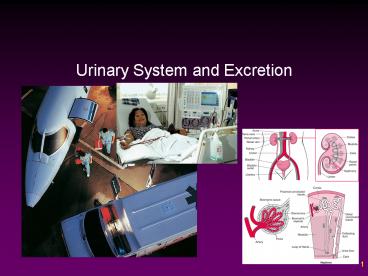Urinary System and Excretion - PowerPoint PPT Presentation
Title:
Urinary System and Excretion
Description:
The concave side of a kidney has depression called the hilum where the renal ... to the glomerulus, then to the efferent arteriole and then to the peritubular ... – PowerPoint PPT presentation
Number of Views:110
Avg rating:3.0/5.0
Title: Urinary System and Excretion
1
- Urinary System and Excretion
2
Outline
- Overview of the Urinary System
- Functions of the Urinary System
- Urination
- Kidney Structure
- Nephrons
- Urine Formation
- Maintaining Water-Salt Balance
- Reabsorption of Water
- Reabsorption of Salt
- Kidney Problems
3
Urinary System
- Kidneys are primary organs of the urinary system.
- The concave side of a kidney has depression
called the hilum where the renal artery enters
and the renal vein and ureters exit the kidney. - Urinary bladder gradually expands as urine
enters. - Urethra extends from the urinary bladder to an
exterior opening.
4
The Urinary System
5
Functions of the Urinary System
- Function of the urinary system is to produce
urine and conduct it outside the body. - Excretion is the removal of metabolic wastes from
the body. - Defecation refers to the elimination of feces
from the body.
6
Functions of the Urinary System
- As urine is being produced, the kidneys
- Carry out excretion of metabolic wastes.
- Urea is the primary nitrogenous end product, but
ammonium, creatinine, and uric acid are also
excreted. - Maintain salt-water balance of blood and thus
blood volume and blood pressure. - Maintain acid-base balance of the blood.
- Have a hormonal function.
7
Urination
8
Kidney Structure
- The kidney contains three major regions
- Renal cortex.
- Renal medulla.
- Renal pelvis.
- Microscopically, the kidney is composed of over
one-million nephrons that produce urine.
9
Kidney Gross Anatomy
10
Anatomy of a Nephron
- Each nephron has its own blood supply.
- From the renal artery, afferent arteriole leads
to the glomerulus, then to the efferent arteriole
and then to the peritubular capillary network
which surrounds the nephron. - From there blood goes into a venule that joins
the renal vein.
11
Nephron Anatomy
12
Parts of a Nephron
- Each nephron is composed of several parts.
- Glomerular capsule.
- Proximal convoluted tubule.
- Loop of the nephron (loop of Henle).
- Distal convoluted tubule.
13
(No Transcript)
14
Urine Formation
- Urine formation is divided into three steps.
- Glomerular filtration.
- Tubular reabsorption.
- Tubular secretion.
15
Maintaining Water-Salt Balance
- Reabsorption of Water.
- Excretion of hypertonic urine is dependent upon
reabsorption of water from the loop of the
nephron and the collecting duct. - Osmotic gradient exists within the tissues of the
renal medulla. - Antidiuretic hormone (ADH) released by the
posterior lobe of the pituitary causes more water
to be reabsorbed and less urine to form.
16
Reabsorption of Water
17
Maintaining Water-Salt Balance
- Reabsorption of Salt.
- Kidneys regulate bloods salt balance by
controlling excretion and reabsorption of various
ions. - Usually more than 99 of sodium filtered at the
glomerulus is returned to the blood. - Most is reabsorbed at the proximal convoluted
tube, while a sizeable amount is reabsorbed from
the convoluted tubule and collecting duct.
18
Reabsorption of Salt
- Aldosterone regulates sodium reabsorption.
- Renin is an enzyme that converts angiotensinogen.
- Atrial natriuretic hormone promotes sodium
excretion. - Diuretics increase urine flow.
- Alcohol.
- Caffeine.
19
Homeostasis
- The kidneys are primary organs of homeostasis
because they maintain acid-base balance and
water-salt balance of blood. - Kidneys reabsorb bicarbonate ions and excrete
hydrogen ions as needed to maintain normal blood
pH.
20
Problems with Kidney Function
- Many types of illness cause progressive renal
disease and ultimate renal failure. - Diabetes.
- Hypertension.
- Inherited conditions.
- Treatment of renal failure can include
hemodialysis and kidney replacement.
21
Review
- Overview of the Urinary System
- Functions of the Urinary System
- Urination
- Kidney Structure
- Nephrons
- Urine Formation
- Maintaining Water-Salt Balance
- Reabsorption of Water
- Reabsorption of Salt
- Kidney Problems
22
(No Transcript)































